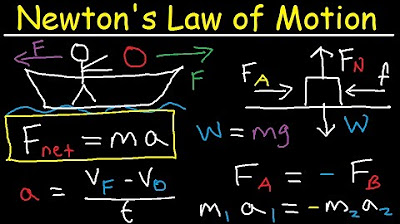Newton's 3 Laws, with a bicycle - Joshua Manley
TLDRThis script explores the principles of motion as explained by Newton's Laws, focusing on the bicycle as an example. It begins by highlighting the difficulty of initiating movement due to inertia, as described by Newton's First Law. The necessity to apply force to overcome this inertia is detailed in Newton's Second Law, where the force equals mass times acceleration. Finally, Newton's Third Law is used to explain the forward motion of a bicycle, illustrating the action/reaction pair between the bicycle's tires and the Earth's surface, which propels the rider forward.
Takeaways
- 🚴 Starting a bicycle requires overcoming inertia, the tendency of objects to resist changes in their state of motion.
- 📜 Newton's First Law, or the Law of Inertia, states that objects at rest stay at rest and those in motion stay in motion unless acted upon by an external force.
- 🔢 Newton's Second Law explains that force equals mass times acceleration, indicating that greater force is needed to accelerate heavier objects.
- 💪 The force to overcome inertia when cycling comes from the legs pushing down on the pedals.
- 🚀 The harder you push on the pedals, the greater the force applied, resulting in quicker acceleration.
- 🔄 Newton's Third Law states that for every action, there is an equal and opposite reaction.
- 🏎️ When cycling, the backward push of the tires against the ground (action) is met with an equal and opposite forward push from the ground (reaction), propelling the bicycle forward.
- 🌍 The Earth's immense mass means it barely moves when自行车tires push against it, but the bicycle moves forward significantly.
- 🤔 Understanding the laws of motion helps explain the physical interactions between a bicycle and its rider with the environment.
- 🌟 The principles of inertia, force, and reaction are fundamental to the operation of not just bicycles, but all moving objects.
- 🛤️ The forward motion of a bicycle is a result of the continuous action/reaction cycles between the bicycle's tires and the Earth.
Q & A
What makes it harder to start pedaling a bicycle than to maintain a constant speed?
-Starting a bicycle requires overcoming inertia, which is the tendency of an object to resist changes in its state of motion. Once the bicycle is in motion, it continues moving due to this same inertia, making it easier to maintain speed than to initiate movement.
What is Newton's First Law of Motion also known as?
-Newton's First Law of Motion is also known as the Law of Inertia. It states that an object at rest stays at rest and an object in motion stays in motion with the same speed and in the same direction unless acted upon by an unbalanced force.
Outlines
🚴♂️ Newton's Laws of Motion and Bicycle Dynamics
This paragraph introduces the concept of inertia and Newton's First Law of Motion, explaining why it's harder to start pedaling a bicycle than to maintain a constant speed. It discusses the tendency of objects to stay in their current state, whether at rest or in motion. The paragraph then transitions into Newton's Second Law, which relates force, mass, and acceleration, and how it applies to overcoming inertia when starting to pedal. Finally, it touches on Newton's Third Law and its relevance to the forward motion of a bicycle, using the action/reaction principle to explain how the bicycle moves forward despite the forces acting on it.
Mindmap
Keywords
💡Pedaling
💡Inertia
💡Newton's Laws of Motion
💡Force
💡Mass
💡Acceleration
💡Reaction
💡Action/Reaction Pair
💡Constant Speed
💡Bicycle Dynamics
Highlights
Bicycle motion and Newton's Laws of Motion are interconnected.
牛顿在17世纪描述了运动的基本定律,帮助我们理解自行车的运动原理。
牛顿第一定律,也称为惯性定律,解释了为何静止的自行车保持静止状态,运动的自行车保持运动状态。
运动的物体倾向于保持运动状态,静止的物体倾向于保持静止,这是惯性的体现。
要让自行车开始移动,需要克服惯性。
牛顿第二定律解释了如何克服惯性,即力是质量与加速度的乘积。
施加的力越大,加速度越快。
自行车和你的质量越大,为了达到相同的加速度,需要施加的力也越大。
牛顿第三定律解释了自行车为何向前运动,即每个作用力都有一个相等的反作用力。
当你的自行车轮转动时,轮胎接触地面的部分向后推地面,这是作用力。
地面以相同的力向前推轮胎,这是反作用力。
由于地球相对于自行车非常巨大,它几乎不会因轮胎的推力而移动,但你会向前推进。
自行车的两个轮胎与地面形成两个作用/反作用对。
牛顿的运动定律不仅适用于自行车,也适用于其他物体的运动。
理解自行车的运动可以帮助我们更好地理解物理定律在日常现象中的应用。
牛顿的定律揭示了力和运动之间的基本关系。
通过牛顿定律,我们可以预测和解释物体在力的作用下的运动状态。
Transcripts
Browse More Related Video

Newton's Laws of Motion

GCSE Physics - Newtons First and Second Laws #56

Newton's Laws of Motion and Forces

Inertia - Basic Introduction, Torque, Angular Acceleration, Newton's Second Law, Rotational Motion

AP Physics 1 Dynamics (Forces and Newton’s Laws) Review

Newton's Law of Motion - First, Second & Third - Physics
5.0 / 5 (0 votes)
Thanks for rating: